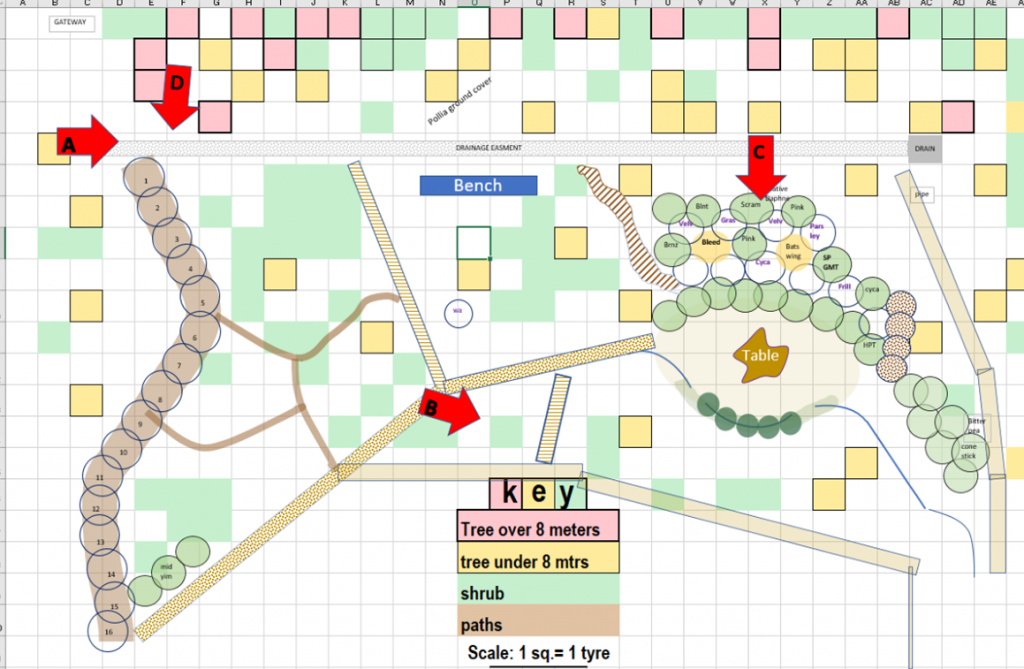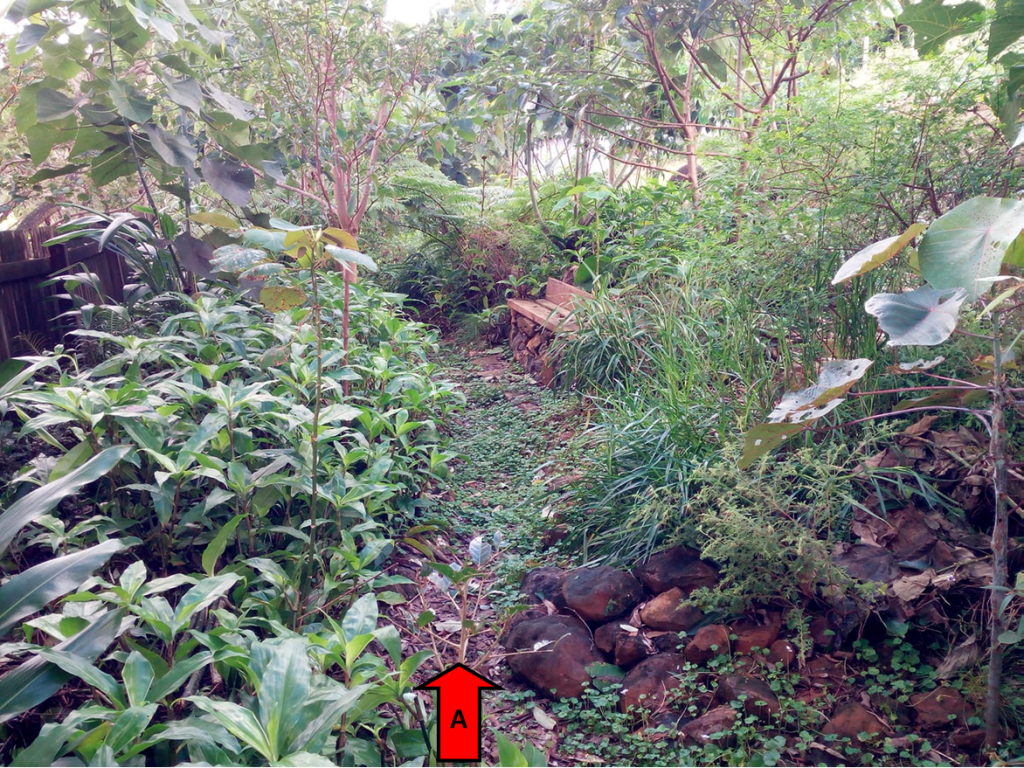words by Frances Harper
Jinibara country
The journey for my garden started during Covid isolation in March 2019. The below pic shows the area we created that is about 20 metres between side boundaries, and approximately 8 metres from the rear fence. This area initially had a 20% slope down towards the Maleny Showgrounds, until the digging of the drainage easement resulted in a steeper 25 to 30% slope.

I have used a spreadsheet to try to keep track of what I have planted. I am not knowledgeable about local plants, so this helps me to keep track of what I have planted. I am reproducing it here (a simplified version) to help others understand the layout of the area (see below).

The ground on the far side of the rear boundary fence continues to slope down to the showgrounds, and erosion has occurred, resulting in the rear fence foundations becoming exposed. A tyre retaining wall was built next to the fence, to support the garden and prevent further erosion. I managed to collect old tyres for free and I hope that this method of recycling is better than using new concrete blocks. There is a length of geotex cloth running behind the tyres to stop the soil being washed between them. When this wooden fence eventually rots, I hope not to replace it.


My daughter and I built this concrete block wall during lockdown. It marks the uphill edge of the garden. I am very pleased to have eliminated a lawn edge line for this Gardens For Wildlife area!
Planting started at the bottom of the block. By January 2021 the young planting was looking like this (below left), with some help through the summer by some overhanging shade from trees on the showground side.


The main planting philosophy was (and is) to plant lots— nearly all Barung tubestock and cuttings. I planted Macaranga, Native mulberry and Bleeding hearts for fast growing shade trees and a mixture of anything that the label suggests might be suitable.
I chose for a (quoted!) maximum height of 10 metres near the fence, and reducing up the hill. A few understorey plants were planted where I thought they would have sufficient shade from the showground trees. Ground cover of Native violets, Native mint and Pollia cuttings were spread throughout, and they have been joined naturally by another native grass; rather a surprise because I hadn’t noticed it before!
More tyres went into this set of steps (above right). The tyres are filled with stones and finished with two double height bricks to provide level footing.

Fourteen months later this is the progress. All the stones and rocks have been rescued from the soil that was moved during the landscaping. The drainage easement has been dug out (with a bit of an artistic wave) and filled with stones.
It has been easy to spread the Native violet with the generally damp weather. The Pollia has spread dramatically, and I am knocking it back to give the trees less competition (which is great for keeping the mulching up). I am really happy to have it shading out weeds and find my weeding is minimal. As the trees grow I imagine they will partially shade out the Pollia, as I have seen along the Obi boardwalk.
The Bleeding hearts, Macarangas and Native mulberries have leapt out of the ground and are starting to provide useful shade. This photo was taken soon after I had taken the tops off some of the Bleeding hearts to let some winter sun penetrate.


I created a flat area which I hope will eventually be a shaded spot for summer. The upside down pots can be sat on. The tyres in the foreground are staggered up the hill, providing a steeper slope than I felt I could manage with the stones and rocks. I understand that tyres will be affected by UV in the long run, but they are intended to be covered by plants.


By May 2022 (above) you can see that the tyres are already disappearing. The trees that I hope will grow to shade the area include Batswing coral tree, Fine leaved tuckeroo, and Deep yellow wood.
This is the view of the garden from my house. You can see the taller trees on the showgrounds side of the back fence. I am sure you will agree with me that the growth has been amazing over the last two summers. It was achieved with no added fertiliser, and individual watering of some plants during establishment. It is an evolving Garden for Wildlife.

Do you have a native garden you would like to share with the world? Email us at gardensforwildlife@barunglandcare.org.au to share your story.

